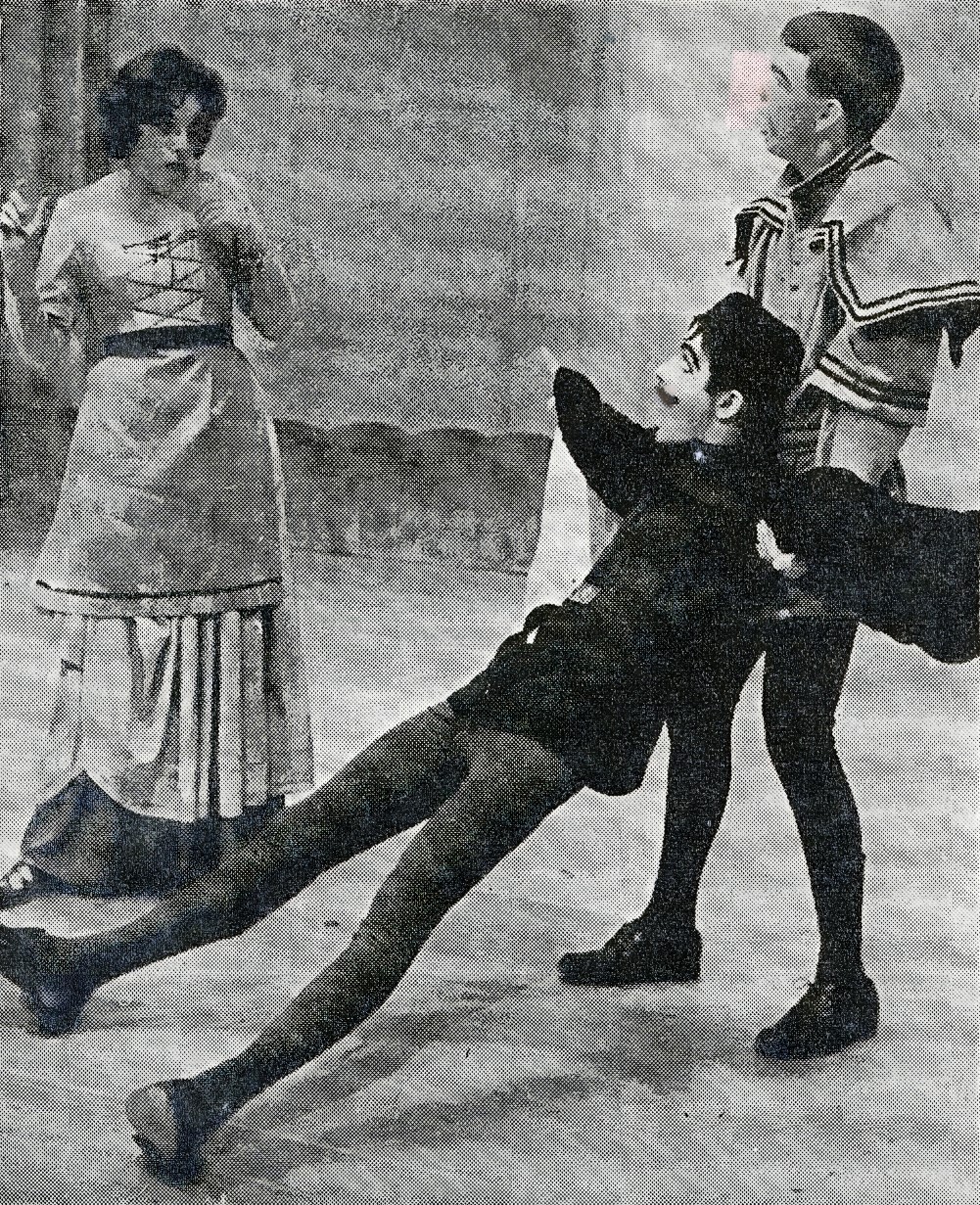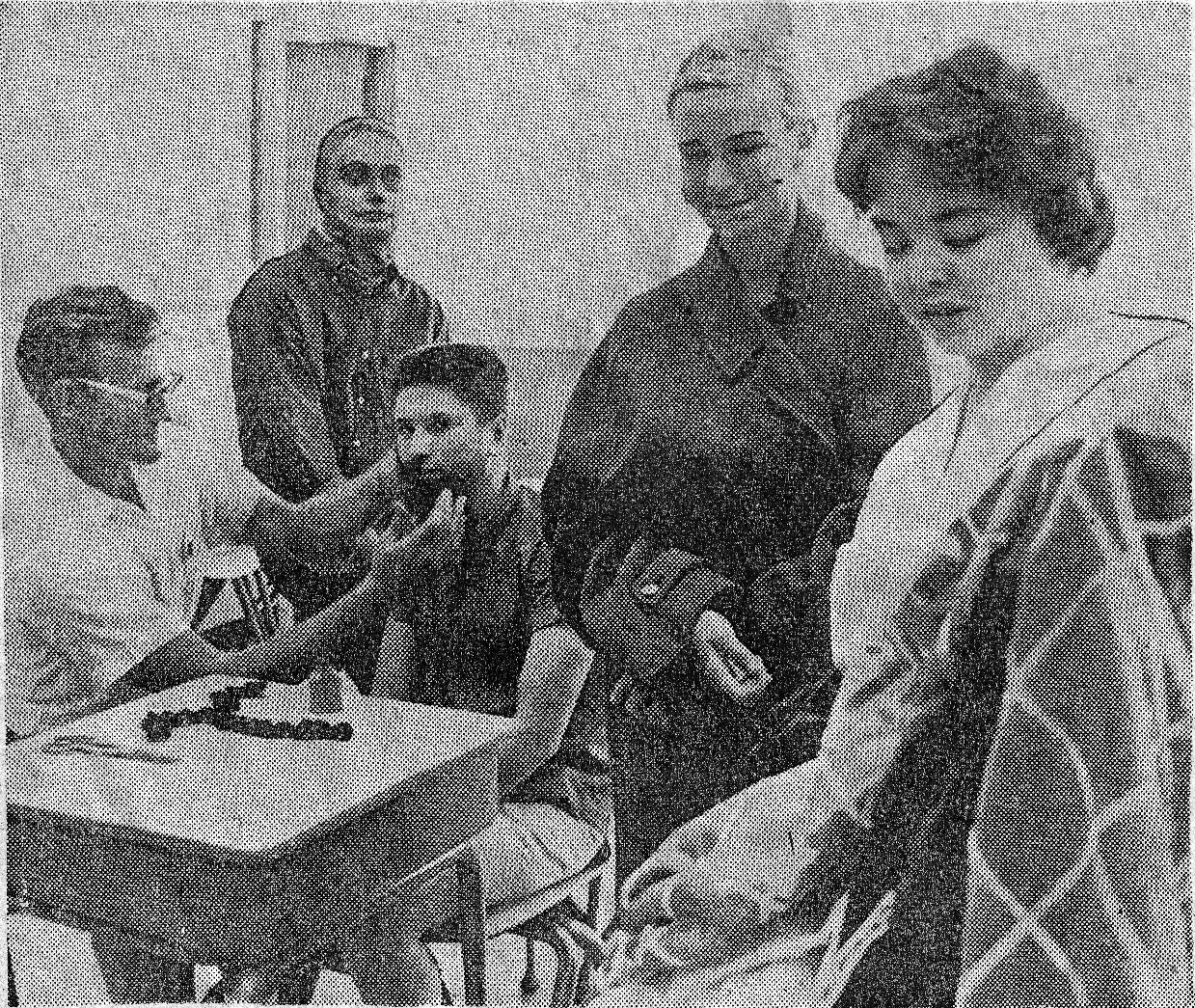The Cat and the Canary
October 27-28, 1961 | John Marshall High School
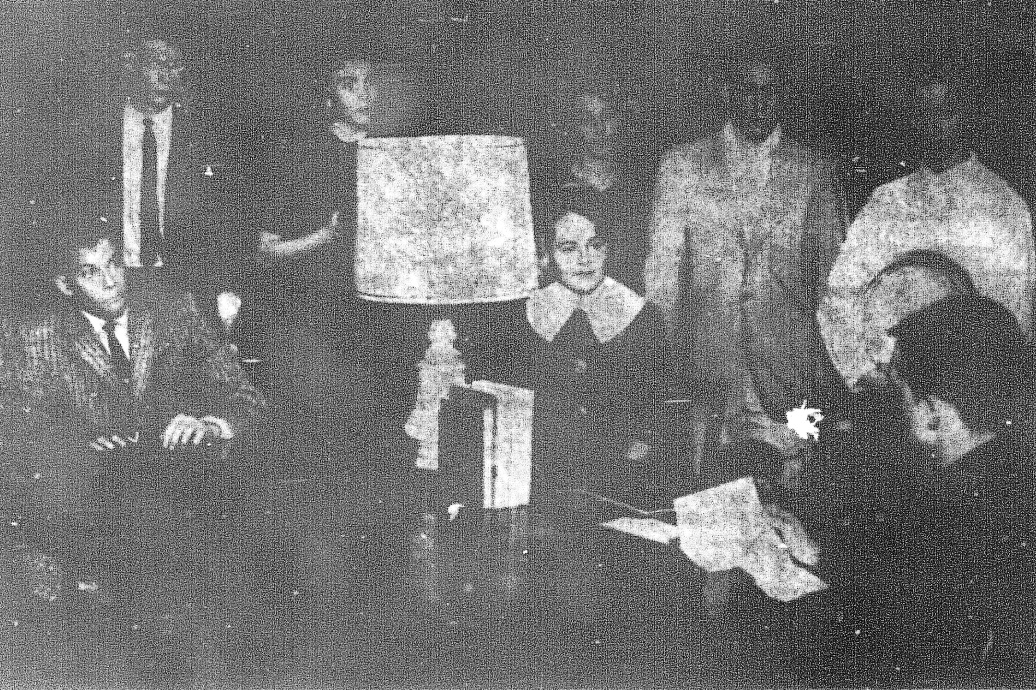 |
| The Cat and the Canary' Rehearsals Under Way |
John Marshall High School cast members of "The Cat and the Canary" are winding up rehearsals in preparation for the public presentations of the exciting play Friday and Saturday nights in the school auditorium. Curtain time is 8 o'clock, and tickets may be purchased at the door before each performance. Pictured in a scene from the popular play are, standing from left, Harry Harwick, Linda Clark, Priscilla Lovestedt, Jerry Bundy and Kristen Miller. Seated from left are Richard Thorkelson, of Kathie Hanson and Joel Barker. Dwain Johnson is directing d the play. (Post-Bulletin Photo) |
Mystic Drama Presentation Set at JMHS
The John Marshall High School fall play, "The Cat and the Canary," a classic mystery melodrama, will be presented for the public Friday and Saturday at a p.m. in the school auditorium.
Director Dwain Johnson, said, "The Cat and the Canary is one of the classic mystery melodramas of preceding generations and still has the same audience appeal today as it did years ago. "Young people will enjoy it because it is 'scary' while the older folks will enjoy the challenge of solving the mystery."
Rehearsals began Oct. 2, and since that time Johnson says he has been trying to create a "mood of menace."
He said "Our goal with the show is to keep the audience at the edge of their seats throughout the play."
Main characters are Annabelle West, a New York singer and dancer who is the intended victim of the "evil" in the show, portrayed by Kathy Hanson; Paul Jones, a veterinarian who reluctantly finds himself a hero, played by Rick Thorkelson; Mammy Pleasant, a West Indies voodoo woman, played by Kristen Miller, and Rodger Crosby, a will executor who is murdered, played by Joel Barker.
Other characters and cast members are Harry Blythe played by Harry Harwick, Susan Sillsby by Priscilla Lovestedt, Sicely Young by Linda Clark, Charlie Wilder by Jerry Bundy, Mr. Hendricks by Terry Terrell, and Dr. Paterson by Bob Kunde. Assistant to the director is Judy Cockrill.
Admission to performances is 75 cents for adults and 35 cents for students through Junior College age. Tickets are available from cast members or those of the production crew. They also may be purchased at the door before the performance. There will be no matinee for John Marshall students.
POST BULLETIN, Rochester, Minnesota, October 23, 1961
JM Students To Present 'Oklahoma!'
The musical comedy "Oklahoma!" will be presented by John Marshall High School students Feb. 27 and 28 at 8 pm. in the high school auditorium.
Dramatic director Dwain Johnson says "Oklahoma!" is a very ambitious undertaking because of the large demand it makes on a blend of acting, music and staging.
"As far as acting is concerned, this is one of the shows in which there is strong need for everyone on stage to establish a definite character. One of the main reasons audiences enjoy the production is that they feel they know all the characters on stage," Johnson stated.
Sidney Suddendorf, musical director, adds, "The orchestra is more important to 'Oklahoma!" than it is to most shows. The orchestra has the job of playing all the background music, playing for three dance sequences and establishing the mood."
Another ambitious feature of "Oklahoma!" will be the use of four complete stage settings. Each of these will be designed to move easily and provide an appropriate background, according to Mrs. Carol Martin, set designer.
The production has 14 speaking roles, a chorus of 34, an orchestra of 25 and a technical crew of more than 20.
Johnson points out that many persons recognize "Oklahoma!" as the first of the modern musical comedies and as such it has be- come a tradition.
He notes that the universal appeal lies with the cowboy theme and with the music. Songs like "Oh What a Beautiful Morning," "People Will Say We're in Love," and "Oklahoma!" have become best-sellers by themselves.
POST BULLETIN, Rochester, Minnesota, January 22, 1962
'Oklahoma!' Model Sets On Display
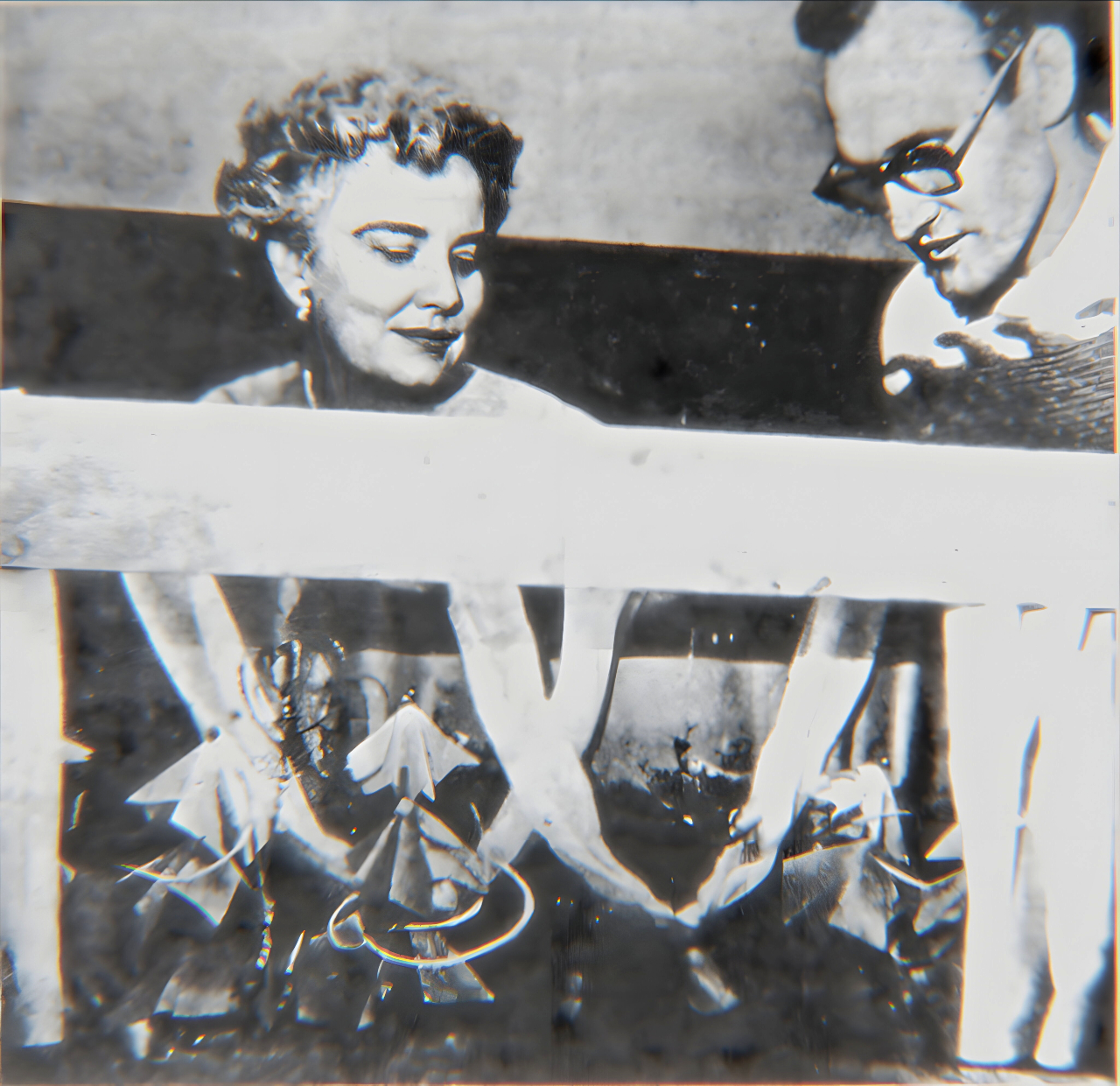 |
| STAGE SETS |
Mrs. Carol Martin and Dwain Johnson look over a scale model of one of the sets which will be used in the John Marshall High School production of "Oklahoma!" The comedy will be staged at the high school auditorium at 8 p.m. Tuesday and Wednesday. (Post-Bulletin Photo) |
Scale models of the basic sets which will be used for the John Marshall High School production of "Oklahoma!" can be seen in the windows of Bach and Welhaven Music Stores.
"Oklahoma!" will be presented for the public Tuesday and Wednesday night in the high school auditorium. Curtain time is 8 o'clock. Tickets will be available at the door before the performance.
Mrs. Carol Martin, set designer, points out that because the models were originally made to guide construction of the actual stage sets, the display models are almost completely accurate.
Dwain Johnson, stage director, says that the sets will appear very unrealistic. "The musical, 'Okla- homa!" is not a realistic show, the characters are not realistic, nor is the plot, so naturally the stage sets could not be realistic," he said. "With 'Oklahoma!' we are trying to establish a mood of fun and gaiety," Johnson observes.
According to Mrs. Martin, although there are only four basic sets, alterations in those sets make possible a total of six different sets. The four sets are:
Set one, with a gay atmosphere based on color and form; set two with a dark, ugly, brutal, and emotional atmosphere; set three with the mysterious and vivid quality associated with love, and set four with a lively, party-like atmosphere.
Once the sets were designed, students took over the job of building them. That job presented problems for a number of reasons.
Gary Schattschneider, head of set construction, pointed out, "Oklahoma!' is the first show at John Marshall to use four completely different sets. For that reason, we had no past experience with the kind of building in needed on these sets."
He also explained that in building all houses using the skeleton effect (rude frames to suggest the presence of a building) it was necessary to make support joints that did not look like joints but were strong.
"One scene needed a house much larger than the door to the backstage storage area. We solved this problem by building the house in two sections and putting them on wagons," Schattschneider said.
However, Schattschneider said construction of the impressionistic sets was not too difficult. Both stage director Johnson and design- er Mrs. Martin believe the four sets create the "Oklahoma!" mood perfectly.
POST BULLETIN, Rochester, Minnesota, February 26, 1962

By DAVID NELSON Post-Bulletin Staff Writer 
Not even the sub-zero weather Tuesday night could cool the ardor and infectious enthusiasm of an excellently prepared cast of 110 members in a performance of Rodgers and Hammerstein's "Oklahoma!" by John Marshall High School students.
Backed up by well-conceived staging, choreography, costuming and the music of an all-time Broadway hit musical, these youngsters turned out an amazingly professional opening night performance which caught the fancy of a near-capacity crowd of 1,850 persons. Strongpoints of the production are the believable characters portrayed in the 18 acting parts. Without this element of stage presence, the whole production could have turned into just another high school presentation. In view of the difficulty of the undertaking. Dwain Johnson, stage director, Mrs. Carol Martin. set designer, and Sidney Suddendorf, musical director are to be commended for their excellent di-rection in channeling the talent of the cast into a finely-honed performance.
In terms of the sports vernacular, "Oklahoma!" was strictly a "team performance" with the whole cast, musicians, dancers and stagehands turning in fine jobs.
In addition to the wonderful exuberance and acting displayed by the cast, the choreography in the "Dream Sequence" midway in the musical attained a high degree of polish and freeness that was pure delight to behold. Once again a precise mood was achieved by good use of lighting and cleverly designed sets.
Fine performances were turned in by the principals-Joel Barker as the young cowboy. "Curley." Marilyn Lake as "Laurey," the young lover. Joan Elkins as the not-too-bright frontier girl, "Ado Annie," Terry Terrell as the vindictive and lascivious "Jud." John Henderson as "Will Parker," the loud, but kindly fellow who re turned from a fling in Kansas City, Harry Harwick as "Ali Hakim" the peddler. Carolyn McGinnis as "Aunt Eller." the old pioneer woman, and others.
While kudos are being handed. out a large share of the credit must go to Gary Schattschneider, head of set construction. Beverly Henderson, assistant to the director, and Judy Cockrill, stage manager, and their crews for the smooth technical and backstage operations which added to the success of the performance.
Singling out certain performers would be a difficult task, but certainly the steady acting of the male actors was noteworthy. John Henderson. Harry Harwick, Joel Barker and Terry Terrell came through strong in this regard Henderson, particularly, displayed fine, all-around ability.
Miss Lake was both beautiful and talented in her part as "Laurey" and Miss McGinnis showed remarkable maturity and a certain sauciness as "Aunt Eller."
All in all it was a fine evening of entertainment that was replete with gaiety, colorful staging, familiar tunes and just plain fun. The whole cast was obviously having a good time and the audience was generous in applauding their efforts.
There was occasionally some difficulty in coordination between orchestra and soloists, and the chorus. Where the difficulty was… with the pitch of chorus and soloists… or the brass section of the orchestra, was not discernible. These problems will no doubt be cleared up for the final performance tonight at 8 pm. Even those persons who expect a professional performance should not be disappointed with this production. What is even more remarkable is the fact that on stage are high school pupils attempting something that far more talented groups would not venture… and they have succeeded.
David Nelson, POST BULLETIN, Rochester, Minnesota, February 28, 1962
'Dark Victory,' Crew Members, Cast Announced
Cast and crew members have been chosen for the play, "Dark Victory," to be presented by John Marshall High School, April 6 and 7.
The leads will be held by Tom Tervo who plays the distinguished surgeon Dr. Frederick Steele, and Judy Cockrill who plays Judith Traherne, the pleasure loving, rich sophisticate.
Other major parts go to Nancy Scott, who plays Miss Wainwright, Dr. Steele's assistant, Jay Knox, as the successful physician Dr. Parsons, and Sandra Rust as Alden Blaine, the society writer.
The rest of the cast includes Doug Larson as Bill Ewing, Sue Vandervort as Connie, Candy Quick as Janette Borden, and John Henderson as Leslie Clarke, all of the sophisticated country club set. Mary Winkle plays Miss Jenny, the ex-school teacher, Clague Hodgson plays Michael, Kris Miller as Josie, Tom Mahler as a postman and Maurice Stauffer as a man round out the cast.
The stage manager for the play will be Connie Williams. The set construction and painting will be done by Tom Cuffel, Ward Whitting, Jim Clagett, Tyler Monson, Terry Terrell, Steve Roessler and Gary Rundell.
Lights and sound will be taken care of by Maurice Stauffer, Tom Mahler, and Duane Erdman, while properties will be in the hands of Carolyn McGlinnis, Vicky Noser, Bob Needham, and Rosalyn Rydeen.
The publicity is being handed by Kathy Rowland, Joan Elkins, and Peter Lodge. Sue Hokanson and Rita Hunt are in charge of costumes, while Rick Thorkelson and Glenn Purdue are in charge of business.
Cheryl Kranz will be the chairman of the make-up committee consisting of Nancy Martens, Car- la Heymann, Cheryl Winter, Pat- tie Morris, Bob Chapman, and Pat Andersen. John Pearson is in charge of the curtain.
"Dark Victory" is a heavy tragedy which opened on Broadway in 1934, starring Tallulah Bankhead and Earle Larimore. It was later made into a successful movie with George Brent and Betty Davis. According to Dwaine (sic) Johnson, director, it is an ambitious play for any high school group and the most serious one yet attempted at John Marshall.
Serious Drama Comes of Age At JMHS in 'Dark Victory' 
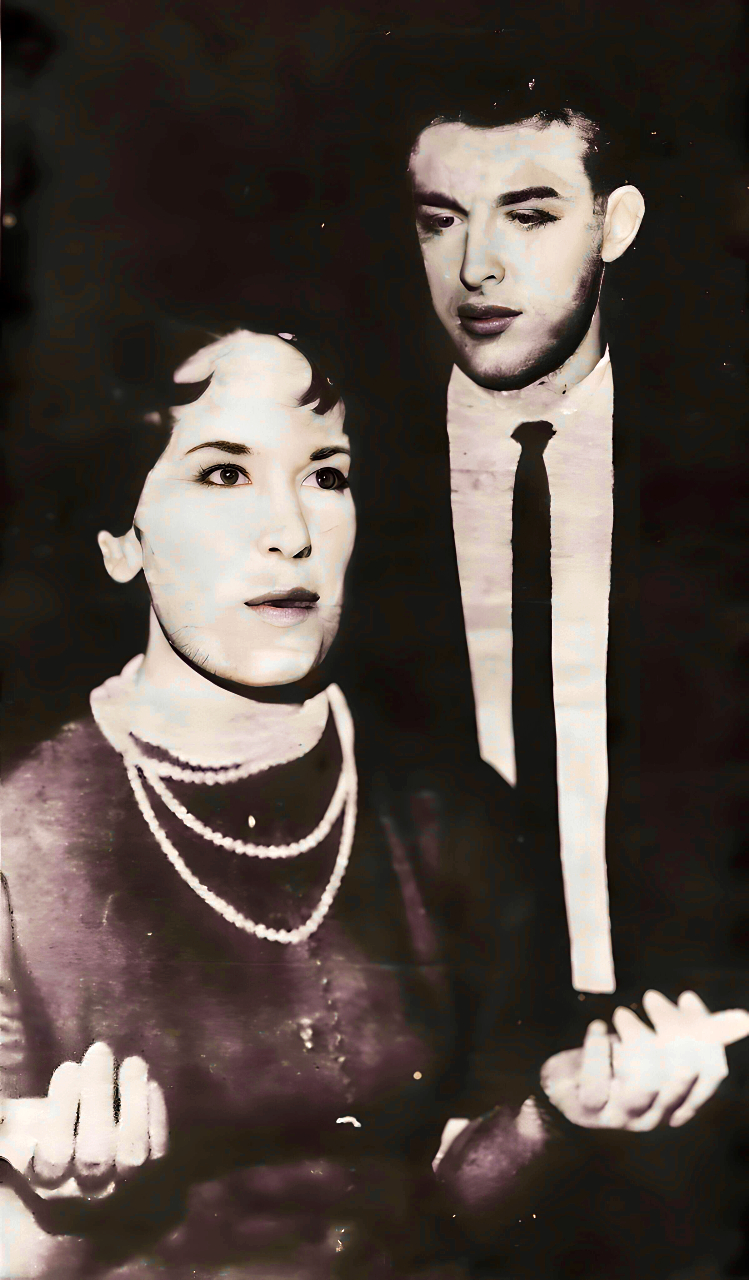 |
| 'Dark Victory' Presentation Set |
"Dark Victory," a serious drama produced on Broadway in 1934 starring Tallulah Bankhead, and later adapted for the screen starring Bette Davis and George Brent, will be presented by the John Marshall High School Drama Department under the direction of Dwain L. Johnson Friday and Saturday at 8 p.m. in JMHS Auditorium. Shown here are Judy Cockrill as Judith Traherne and Thomas Tervo as Dr. Frederick Steele, in a scene from the play. (Post-Bulletin Photo) |
Serious drama came of age at John Marshall High School Friday night in the presentation of "Dark Victory."
Director Dwain Johnson attempted a daring experiment of having high school actors put on a drama requiring emotional and traumatic responses beyond their own life experiences. Yet, the cast of 14 actors turned in a fairly mature performance that was well received by an audience of 500 people.
Once again Johnson has scored a technical triumph in drilling the cast on stage movements. India, will be the guest speaker Their performance in this phase was meticulous in detail and movements, gestures and timing had real meaning in getting the message of the play.
It is too much to expect that the characters could keep up the emotional pitch of their parts throughout the play. Most consistent performance in this regard was given by Judy Cockrill in the part of Judith Traherne, the tragic heroine.
Miss Cockrill immersed herself in the part and came up with a characterization that was consistent, believable and emotionally projected.
Thomas Tervo in role of Dr. Frederick Steele, the brilliant, young brain surgeon, did a fine job but slipped out of character when he rushed his delivery.
One of the real surprises of the play was some pretty good type-casting and several strong supporting roles. It is not always easy for a young actor with a smaller part to plunge himself into an off-beat role in a drama. John Henderson, who turned in such a fine performance in "Oklahoma." again displayed some polished acting in the role of Leslie Clark, a tipsy, fun-loving, "live for today... " sort of person. The levity and humorous interlude he provided during a scene did much to keep the play on an even keel.
Also turning in fine supporting calling performances were Mary Winkle as Miss Jenny, Sandra Rust as Alden Blaine, Jay Knox as Dr. Persons and Clague Hodgson as Michael.
Appearing in the play also were Nancy Scott, Doug Larson, Sue Vandervort, Candice Quick, Kris Miller, Thomas Mahler and Maurice Stauffer.
The backstage crew did a good job and the sets, props and costumes were in good taste. Modern in concept, the sets were unobtrusive and functional. The placement of a window was probably too low for the stage in several scenes.
The over-all performance was a bit uneven when lines were rushed or missed. This did not detract from the play's message, even if continuity was sidetracked occasionally.
Director Johnson wrote in the program, "Serious drama is an integral part of any dramatic program. Past experience has indicated that high school students do not want only comedies, but they can and do appreciate a show with a message."
He added. "A group of young actors can attain a new concept of themselves when they are asked to vicariously experience and demonstrate traumatic, emotional responses beyond their own experiences. As the characterization develops, so must maturity."
For these reasons I believe that serious drama has "come of age" at John Marshall High School with it the pitfalls and shortcomings which arise when young actors broaden their outlook by attempting difficult plays and attaining a bit more maturity in the process.
David Nelson, POST BULLETIN, Rochester, Minnesota, April 1962
JOHNSON -- 4,000-PLUS SEE 'ABNER'
On Feb. 25 and 26 "Li'l Abner" was staged to well over 4,000 people, according to Mr. Dwain Johnson. stage director for the JM musical.
Mr. Murry Whynaucht, head custodian at JM, estimated the crowd for the second night at 2,175. "It's the largest crowd that we've had in the auditorium since JM has opened. We set up about 200 extra chairs." he said.
Mr. Johnson said that he thought the Feb. 26 performance was played to the largest audience ever to at-tend a public theatrical perform-ance in the history of Rochester.
As of last Tuesday, $2,233 had been collected from ticket sales.
Bills for the show are expected to reach about $1,300. The largest cost was for rentals and royalty.
THE PROFIT of $1,000 will go in-to the operetta fund which is now about $1,290.
Mr. Sidney Suddendorf, music director, said, "The audience was very enthusiastic and appreciated all aspects-art. music, and staging."
Mr. Johnson said, "I think, for a show of its size, it was the most solid show I've ever been involved in."
He went on to praise the discipline of the chorus and orchestra, the dedication of the crew, and ability of cast and chorus to develop unique characterizations.
He said he was also pleased that they had been able to take a basic-ally satire-musical, change it into a farce comedy, and succeed.
WITH THE MUSICAL out of the way. Mr. Johnson has now cast "Charley's Aunt" a farce comedy to be presented April 26 and 27 as the spring play. The play is one of the classic comedies written in the early 1900's.
THE POST-BULLETIN, Rochester, Minnesota, February, 1963
Last 'Li'l Abner' Show Attracts Overflow Crowd
John Marshall High School's Fine Arts Department production of the musical comedy "Li'l Abner" closed its two-night run Tues-day before a packed audience in the school auditorium.
Attendance last night in the 1,960-seat auditorium was estimated by JM officials at about 2,000 persons. Extra chairs were set up to handle the overflow seating. Monday's attendance was just short of the 1,960 capacity.
The three directors largely re-sponsible for the colorful, entertaining production were Dwain Johnson, stage; Sidney Suddendorf, music, and Mrs. Carol Martin, stage settings.
"Charlie's Aunt" is the next scheduled production at JM and will be staged sometime in April. Casting for the comedy begins next week.
THE POST-BULLETIN, Rochester, Minnesota, February, 1963
EDITOR'S NOTEBOOK By PAT ANDERSEN
A popular pig spices the air for Abner' cast and crew
"Pigs is pigs," one writer says. But George (who just oinks ) is a species all his own.
Actually, George the Pig is the only character still alive from JM's production of "Li'l Abner" several weeks ago. He was our mascot, our star, and our main prop all rolled into 15 solid pounds (which have now increased to more than 25) of pig flesh.
I first realized my fate in that musical when I read my second line as "Moonbeam McSwine." it said, "Sleepin' out with pigs is my line."
Consequently, one week before opening night I had to drive out to the country to pick up my roommate. Previously, I had made some corny statement that I could carry any size pig across stage. I swallowed the foot I had so carefully placed in my mouth when I saw George and learned that he was one of the smallest pigs on the farm.
He was a rather cute little devil, with a curly-cue tail, black-and-white coloring, pointed ears, and a gluttonous smile. I soon learned how to carry him like a football, pick him up by his hind leg, and scratch behind his ears when he grunted and squealed.
George became a guest of Mr. W. 0. Woodman. JM's agriculture teacher, who kept him in a strong pen (which no wolf could blow down). There he received an overabundance of feed and water, the results of which too soon became apparent.
During his first rehearsal, George experienced a case of stage fright and squealed so loudly off key during the "Jubilation T. Cornpone" song that he had to exit quickly. A few scenes later, however, he was back on stage-with a few strips of tape around his snout. He soon caught the theater bug and a few scenes later wandered nonchalantly on stage during the ballroom scene.
George became quite tame after a few rehearsals. But even though his squealing episodes ceased, he still grunted frequently. That proved embarrassing during one of the director's vehement speeches to the cast. "If there is anyone here who thinks he doesn't need another rehearsal, let him tell me," the director said.
Guess who made the only reply.
We decided to give George a tranquilizer on the opening night of "Li'l Abner" to help steady his nerves and reassure ours. Although he managed to swallow the pill, its only effects were those of a laxative.
Oh, George, I would have forgiven you if only you could have controlled it during curtain call. But, alas!
Of course, parting is sweet sorrow, and George left us in true Dogpatch style. In a crate on his return to the farm, he showed his nostalgia for "Li'l Abner"-for this little piggy cried all the way home.
As I watched George readjust to his pen on the farm, I said a silent "Thank You'' to him for spicing our spirit (though not the air) - and then home again, home again.
Jiggety jig.
Pat Andersen, JOHN MARSHALL ROCKET, Rochester, Minnesota, 1963
By KENNETH MCCRACKEN, Post-Bulletin Staff Writer
Talented Cast Presents Sprightly 'Li'l Abner' Performance at JM 
A gay, animated bunch of high school kids brought "Dogpatch, U.S.A." to Rochester Monday night-and a refreshing, highly entertaining night of singing and music it was.
The musical comedy, "Li'l Abner" staged by John Marshall High School's Fine Arts Department would have warmed the heart of Al Capp, the syndicated comic strip's creator.
They tell me cast, crew, orchestra, behind-scenes technicians, directors and allied help numbered about 250 to stage Abner. The success of last night's production and the harmonious teamwork was enthusiastically endorsed by the almost 1,960 first-nighters packing the high school's auditorium. Frequent and spontaneous applause punctuated many of the more intricate scenes.
FROM SINGING, dance routines and orchestration to lighting and novel stage settings, the entire musical comedy production was a polished performance.
Only a young, exuberant and uninhibited cast could have brought the spontaneous gaiety and animated color and life to "Li'l Abner" and the JM performers had the show nailed down pat. Where to begin?
Well, take Daisy Mae, for in- stances-and who wouldn't like to take her... JM's ingenue, pretty Elaine Swenberg, seemed to step right out of the comic strip char- acter just for the benefit of last night's show. Her well-acted role of the demure, innocent but determined-to capture Li'l Abner, that is-Daisy Mae was enchantingly complimented by her strong, clear young singing voice.
Some well-wisher sent her a bouquet of flowers on stage after the final curtain. She certainly rated the gesture.
The role of Li'l Abner, continually on the run-- well, almost continually-- from Daisy Mae, was entrusted to Charles Larson, a talented young JM student with genuine stage presence. His comical interpretation of the bumbling, overall-clad darlin' of Dogpatch made one suspect he had been reading the comic strip since childhood.
IT'S DIFFICULT when a play is so well executed thanks in large part to director Dwain Johnson-- to select individual outstanding performances.
But to list just a few there was Cheryle Winter, a delightful Mammy Yokum . . . Steve Wagner, who could almost make a living professionally as Pappy Yokum... Frank Borg, as ground- trembling Earthquake McGoon... Dwight Hough, a Hairless Joe who probably gave any barbers in the audience an itch to reach for the clippers . . . William White, a more sinister, creepy Evil Eye Fleagle never skulked through the Sunday comic supplement.
Gary Winter, as Senator Phogbound, and David Vale as Mayor Dawgmeat, aided immeasurably in the smash success of last night's show, as did Rick Thorkel- son, as money-grabbing tycoon General Bullmoose, and James Clagett as the redoubtable Mar- ryin' Sam.
It is impossible to list the entire cast of Lil' Abner in this review, but all deserve accolades for jobs well done.
Not to be overlooked was the excellent chorus-- suitably draped in "typical" Dogpatch finery-- which lended so much color and background to the staging of the musical comedy.
The 32-piece John Marshall Orchestra -- largest in the school's theatrical career complete and perfectly attuned harmony with the bouncing, singing, laughing on-stage Dogpatchers. Sidney Suddendorf, conductor, and his musicians took a well- deserved bow to heavy audience applause when the final curtain rang down.
A pleasant innovation during the play was introduction of each new set change when the actors and 5 actresses crashed through a mammoth Al Capp-type cartoon back- dropping the stage.
ON REFLECTION, aside from the hours and hours of rehearsal and painstaking attention to detail that obviously were spent in polishing the show to its fine polish, one of the key ingredients marking its success was the lack of psuedo-sophistication and studied efforts so common to amateur productions.
"Li'l Abner" is full of the vigor of youth, laughter and brimming, with wholesome comedy and song. Its student cast, a little mischievous, fun-loving and hearty, obviously was as entertained as the audience.
The show can be seen again at 8 p.m. today. For the caliber of entertainment presented, the $1 adult and 50 cent student ticket tabs almost are a mere formality. I've seen musical comedies in New York at up to $10 per ducat that didn't furnish a particle of the a relaxation and entertainment I saw last night.
It's a darned good show, John Marshall. Let's have another one like it real soon. Rochester is richer for them.
Kenneth McCracken, THE POST-BULLETIN, Rochester, Minnesota, February 26, 1963
'Medea' Cast Meets Difficult Challenge 
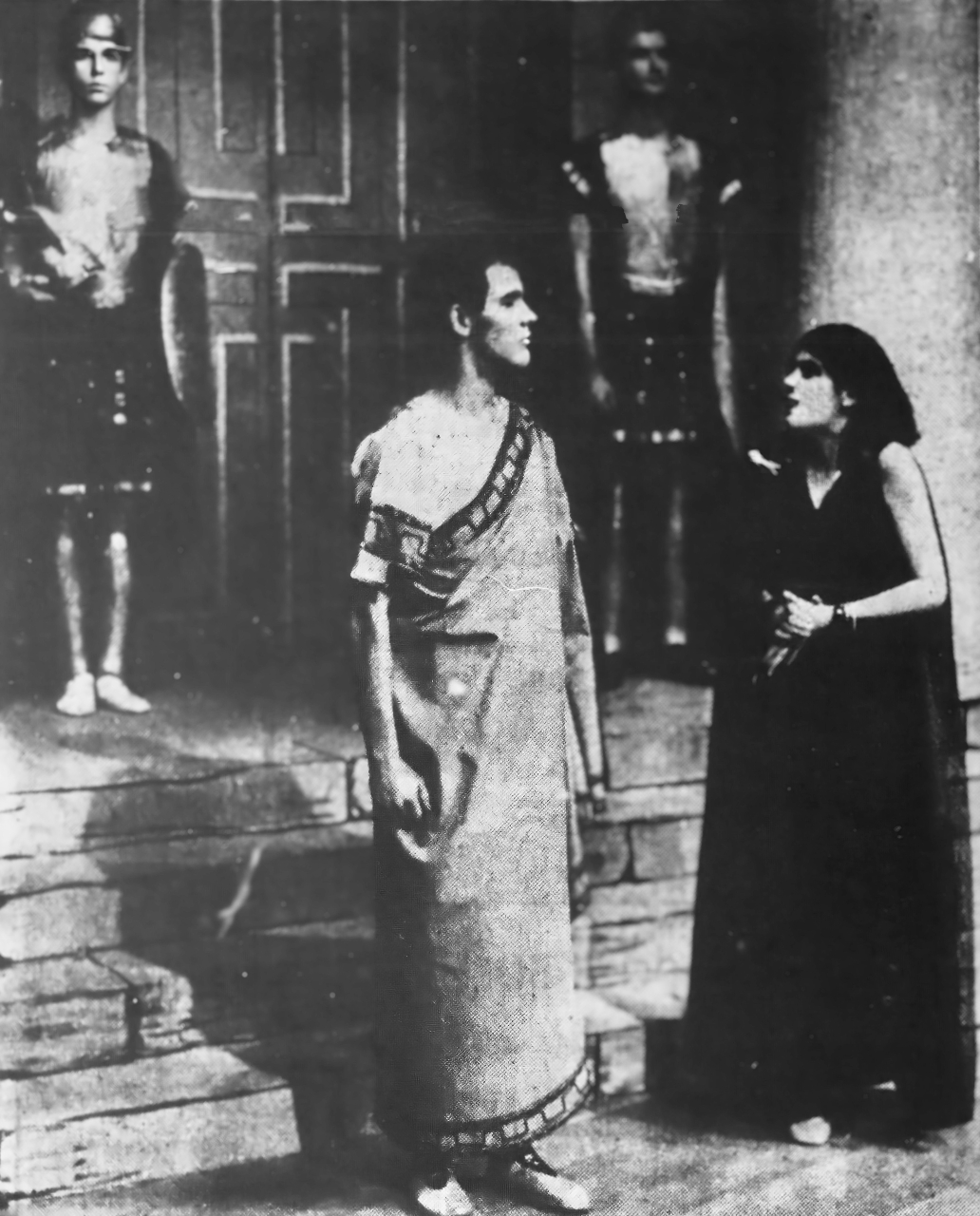 |
| JMHS Students Rehearse 'Medea' |
Striking a pose from "Medea," a Greek tragedy which will be performed in its modern adaptation here Friday and Saturday, are John Marshall players Ron Bowman and Diane St. George, foreground, and Terry Moore, left, and John DeWitt, posing as guards. The Euripides play, adapted by Robinson Jeffers, will be staged at 8 p.m. Friday and Satur- day in JMHS auditorium and will be directed by Dwain Johnson, JMHS English and Speech instructor. (AI rendering of a Post-Bulletin Photo)) |
The John Marshall High School Players conducted an experiment in drama Friday night at the high school auditorium with the performance of the Greek tragedy, "Medea.' The result was exciting theater.
A tragedy is the highest and most complicated form of drama calling for the full range of emotions and is seldom attempted by so young a group for this reason alone.
Greek tragedy is even more challenging because little action takes place on the stage. All violence occurs off stage with a messenger bringing reports of the deeds to the awaiting actors. In addition the stage is very bare with only a facade of a building and little less. Thus the performers must hold the attention of the audience with only the words of the playwright. And the cast of 'Medea' did just that.
EURIPIDES STUDY of a scorned woman lacks the conventional plot. Rather is it an investigation of the feelings and motives of Medea. Had Euripides lived in the 20th century, he would have been called a psychological novelist.
"Medea," as adapted by Robinson Jeffers, is the story of the woman who saved Jason from death, helped steal the Golden Fleece, slew her brother and a rival of her husband, deserted her people and bore him two sons. In return, he deserted her to marry the king's daughter to acquire power. Medea was transformed into a raging fury who loved revenge more than her sons. To mete out punishment to Jason, she killed his new bride, the king and the two sons.
The role of Medea belonged to Diane St. George who magnificently possessed the part rather than the part possessing her. see She raged with injustice, and plotted the horrifying reprisal with power, yet softened with the love for the two children who had to be sacrificed. In addition, she carried herself so that she looked like Medea rather than an actress playing Medea.
RON BOWMAN as Jason warmed to his part slowly but by the final scene when he has lost everything, he portrayed excellently the tragic figure who has sentenced himself to despair.
One test of a performance is the quality of acting in the smaller roles. The "Medea" cast did not fail here.
Linda Clark gave a fine rendition of the nurse who consoles and assists Medea and who tells the audience what has happened previously so that background and mood are established.
The small role of Aegeus who offers Medea refuge during her exile was played with firmness by David Vale. In the short time he was on stage, he sharply defined the personality of the visiting king. It would be interesting to see if he could do as well with a larger part.
MIKE GIBBONS' King Creon was a stuffy and proud man and one couldn't feel much regret when he was killed.
The three who were the chorus, Mary Winkle, Cindy Shick and Kristen Miller, deserve commendation for fine work. Their roles are difficult in that they do not portray definite personalities. Instead they sustain the play's major rhythm and beat, supply the lyric note and give an aura of solemnity, of life's meaning illuminated which is tragedy's ultimate effect.
The auditorium was about two-thirds filled. The JM Players deserve a full house for their performance of "Medea." This evening's production, the last night, begins at 8 p.m.
Linda Baughman, THE POST-BULLETIN, Rochester, Minnesota, December 6, 1963
JMHS Students Show Balance, Maturity in 'Miracle Worker' 
Maturity and a balance of character portrayals were highlights of William Gibson's "The Miracle Worker," the beautiful and touching story performed by the John Marshall High School Drama Department Friday night.
Seldom do teenagers possess the emotional responsibility to perform such an "exhausting" performance as "The Miracle Worker." Likewise, casts rarely blend as uniformly as they did for this show.
But above and beyond the expectations of the large audience-- almost jam-packed in the orchestra section of John Marshall auditorium-- were the performances of Lexie Rome and Anne Lofgren.
Advance raves of notice had been bestowed upon these two talented girls, and not a word was exaggerated.
LEXIE AND ANNE had one battle to conquer, especially if individuals in the audience had seen the film version of this powerful story. And that, basically, was fighting a possible impression left by the interpretation of Anne Bancroft and Patty Duke in the two lead roles.
In performing the true story of Helen Keller, a girl with the unfortunate circumstance of being born blind, deaf and mute, Miss Lofgren "stumbles, kicks and feels" herself through the lead role of Helen with the aplomb of a veteran professional.
On the other hand, Miss Rome is presented the task of performing a part that requires restraint, good judgment and patience. Needless to say, she meets each as an individual challenge and enacts a part that an older and more experienced person would find difficult to play.
THE LIFE STORY of Helen Keller is one of many complexities. It is one which cries for a sympathetic viewpoint on parents by the audience, and yet, paradoxically, advocates the practice of good, common sense in raising a child who was the victim of a highly unnatural birth.
"The Miracle Worker" shows very easily how a parent, regardless of the circumstances, will often give a tolerant hand of "selfish love," and eventually lose an arm as a result of the lack of discipline.
As powerful and touching a drama as "The Miracle Worker" is, it also has humorous undertones. And the audience loved every minute of it.
POWERFUL SCENES are the "spoon throwing" and "food spitting" enactments, and the heart rendering final scene, which shows the discovery of "life and love" created by an unselfish teacher for the bid, deaf-mute Helen.
Strong supporting roles are played by Steve Bradley as Helen's father and Bob Cundiff as James. Both add interesting interplays of action to add balance and gusto to the performance.
An excellent way to describe the show is to paraphrase a comment from the program by director Dwain Johnson: "Although our handbills list this play as a production of the dramatics department, it is really a production of the entire high school."
No truer words could be spoken. For the performance of such an outstanding accomplishment is a credit to the entire high school student body.
NOTABLE IN the challenging high school production is a very accommodating stage setting, designed by Joe Zender of St. Cloud State College, and constructed under the supervision of crew head Peter Sanders. Effective lighting and sound effects blend in nicely to create excellent illusions of realism and grandeur. Especially difficult to portray, but well-handled by the young theatrical enthusiasts, are several flashback scenes which are of high importance.
Utilization of a rotating platform for scenery changes is a must in "The Miracle Worker," and, although some of the transitions could have been a trifle quicker, the pace of "The Miracle Worker" is consistent and kept within the limits of a two-hour production.
At times the changes in lighting were rather abrupt, but generally they were handled with pleasant results:
BESIDES BEING a beautiful show to listen to, it is equally as beautiful to watch. With an assist from the Northwest Costume House, the costumes department adds the little things which are so necessary in a rich and tasteful performance. At times, some of the members of the cast could have used more projection as they were a bit hard to hear. John Marshall High School auditorium is large and frequently the actors must work doubly hard to be understood.
Some forethought could have been given to the problem of sight lines. Choice scenes were occasionally lost on the left side of the stage by persons occupying seats in this "hidden section" of the auditorium. Unfortunately, high school drama departments are generally limited in producing a performance longer than two nights of a weekend. That is also true in this case.
Therefore, in able to enjoy an excellent evening of entertainment, it is recommendable to see "The Miracle Worker" at John Marshall High School auditorium. The reward will be a witnessing of professional finesse in stage acting by young, budding thespians. Curtain time is promptly at 8 p.m.
Thomas Furth, THE POST-BULLETIN, Rochester, Minnesota, February 13, 1965
'Hansel and Gretel' Directors Say-- H.S. Summer Theater a Tradition
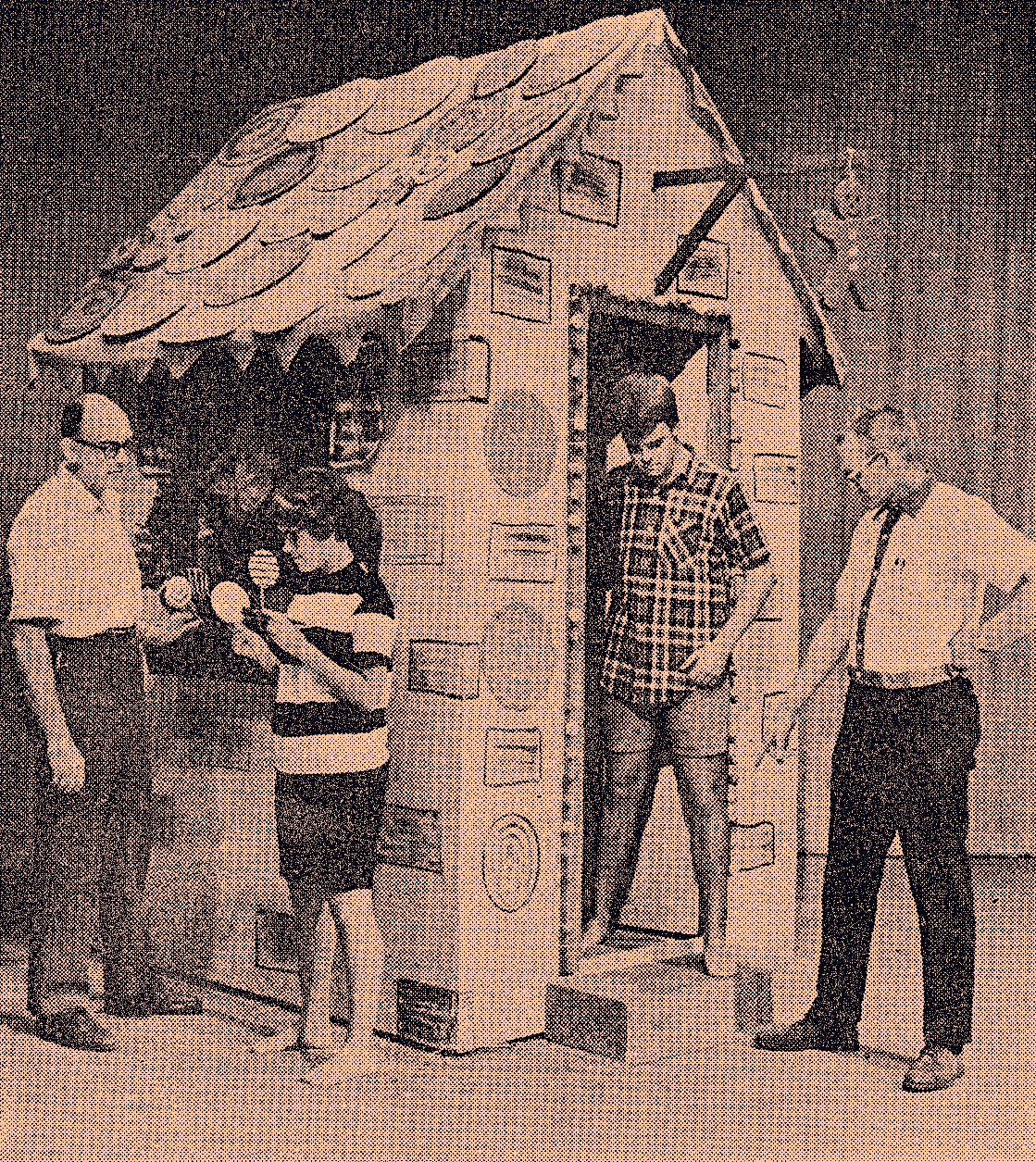 |
| 'PLAY' HOUSE OF EDIBLE ENJOYMENT |
Burdette Moeller, left, and Dwain Johnson, right, co-directors of John Marshall's summer theater production of "Hansel and Gretel" demonstrate techniques in acting and set construction to Randall Holmes and Carol Wegner. The two students, of Des Moines, Iowa and Litchfield, respectively, are enrolled in summer theater during their stay in Rochester for the summer. They helped to construct the Wicked Witch's house, trimmed with real pizza, marshmallows and gingerbread. (P-B Family Fare Photo) |
Stale pizza, colored marshmallows and day-old gingerbread which decorated the fanciful gingerbread house of (the) Witch Wicked in John Marshall's Summer Theater pro duction of "Hansel and Gretel," were contributing factors in appealing to the vivid imaginations of the youthful audience who strongly encouraged the actors during Thursday's matinee. The final performance will be at 7:30 p.m. today in the John Marshall Auditorium.
HIGH SCHOOL summer theater in Rochester has been a tradition for about 15 years, according to Burdette Moeller, technical director for the play. Dwain Johnson has directed the acting.
Since the summer school theater sessions began on June 21, the two John Marshall speech teachers have been instructing a class in stagecraft which is totally new to the summer program. A non-credit course, it was a four-session each day from 8 a.m. to noon. The class dealt with various backstage techniques such as the voluntary as set construction, make-up, costumes and props.
During the morning session, students were briefed on how they should carry out special backstage jobs. Each day from 1:15 to 3 p.m. work sessions have been held specifically for "Hansel and Gretel" and students were able to practice and develop their techniques. For those students with acting parts in the play, rehearsals were held each day from 7 to 9 p.m.
IN CONTRAST to the regular theater work during the school year in which students are given backstage jobs, summer theater allows the student to develop an interest in and appreciation for all aspects of theater, according to Johnson.
Next year the directors plan to allow more time for construction during the class periods. "Techniques such as learning the real way to pound a nail and stroke a paint brush will be taught next year," Johnson said. "We assumed that the students knew these things, but found out that we were wrong."
Two "long distance" newcomers to the summer theater program this year are Carol Wegner of Litchfield who will be a junior and Randall Holmes of Des Moines, Iowa, an upcoming sophomore. Both students are staying in Rochester for the summer.
UNLIKE RANDY, who is participating in theater for the first time with the dual role of an actor and backstage worker, Carol has been active in her school theater group as an actress. However, she doesn't have an acting role in "Hansel and Gretel."
Both students remarked that the voluntary aspects of summer theater helped the actors to strive for personal satisfaction, which when combined with mutual effort, helps to create authenticity and realism in the play.
Carol and the directors contrasted Rochester's theater facilities to Litchfield's by saying that Rochester has the necessary financial backing so that it can't settle for mediocrity. The money problem that exists in communities is enough to cut the heart out of any production, they agreed.
(Johnson added that several JM alumni have noticed the excellent preparation John Marshall has given them for college theater- even commenting that their experiences at JH have topped the "finished product" at college.)
BOTH DIRECTORS were pleased with the initiative developed by many students on the backstage crew. "If the students truly understand the tone of the play, they should know more about the various techniques than the director."
Johnson feels that he is well on his way to achieving such a crew that can stand alone.
Key specialists working on "Hansel and Gretel" have done their own designing and construction with only an occasional suggestion from the directors. They are Tom Parker and Bob Lovestedt on lighting, Jane Kortz on costumes and Barbara Wieland, choreographer and music director.
IN WORKING with "Hansel and Gretel" specifically, the directors have two special problems. Because of the script, it is necessary that Witch Wicked, played by JM graduate Cindy Schick, must fly. A parachute harness and piano have done the job successfully.
Amazingly enough, the colorful gingerbread house was once edible. The withered shutters are fashioned of whole pizzas, complete with sauce. Trim on the door consists of marshmallows dyed in food coloring, and a real gingerbread doorknocker. There is one problem in that they create an offensive odor on stage, commented Johnson.
Summer theater has been fortunate because of its increasing enrollment, he said. "Even though the other classes have decreased, we have held our own."
Johnson concluded that children's theater gives an actor the biggest challenge. "Kids are honest. They can cause our success or our downfall."
Ann Withers, THE POST-BULLETIN, Rochester, Minnesota, July 16, 1965
Molly Brown Was Unsinkable At Opening of JM Production 
John Marshall High School's auditorium rocked with the boisterous music of Meredith Willson, the foot-stomping of enthusiastic "mountain men" and dance hall girls and the laughter and applause of a near-capacity audience Thursday, opening night of the school's production of "The Unsinkable Molly Brown."
The cast sailed along easily and there was never a chance that "Molly" might sink.
Fine acting, lively choreography, some memorable songs and bright sets and costumes buoy- ed up the production. Linda Wooner is excellent as Molly Tobin-Brown, mountain girl who desperately wants to "get society." If she's got to eat catfish all her life, at least she wants to eat off a plate, she shouts during the rousing opening number, "I Ain't Down Yet."
Miss Wooner's enthusiasm for the role is catching and Thursday's audience caught it. She brings sparkle and charm to the character whether clad in dirty jeans and ragged plaid shirt or an elegant silken gown.
MOLLY BROWN is a girl of many moods-- she's tough, gentle, child-like, shrewd and just a little bit naive, Miss Wooner capably handles all of these. And she turns in a good performance as a singer, although Willson's songs are often difficult to sing because they incorporate unusual rhythms and melodies.
Eric Hanson is Johnny Brown, "lucky Leadville Johnny Brown." Hanson, too, performs well, and he even fits the part physically he's tall and handsome, a Rocky Mountain man from Colorado for sure. Willson's songs for this role in "Molly Brown" are especially challenging, but Hanson gives his best in such numbers as "Colorado, My Home" and "I'll Never Say No."
Other standouts in the cast, which numbers about 100, are Bruce Agneberg as Molly's father Shamus Tobin, a dyed-in- the-green Irishman who only wants Molly to "be a good Catholic and learn to fix a meal;" Larry Watson as Father Flynn, the priest who advises Molly to go to Europe to learn to be a lady, and learn something of the world, too: Tom Madson as Christmas Morga proprietor of the Saddle Rock Saloon in Leadville and the man who gives Molly her first job, playing "that box" (a piano) and sweeping the floor, and Dave Watkins as Count Feranti, one of Molly's European friends who falls in love with her.
THE CHOREOGRAPHY in "Molly Brown," under the direction of Mrs. Claire Van Zant, gives some students a chance to show their special talents. At least one scene, in a club off the casino at Monte Carlo, was especially written for Janice Porter, Sue Scudamore, Peg and Pat Easley. The four, dressed in lavender satin dresses, high-step through a gay number with grace and zest. Another light- hearted dance takes place in the Saddle Rock Saloon, to the tune of "Belly Up to the Bar, Boys." Musical credit must go to the John Marshall orchestra, under the direction of Sidney Suddendorf. The orchestra certainly deserved the extra hand it got from Thursday's audience at the play's finale.
The set, by Joseph Zender of St. Cloud State College, and costumes, designed under the supervision of Elaine Fuller and Joyce Seifering, provide an elegant backdrop for the actors and actresses. Ladies parade in long silk and crepe gowns of vivid yellow, blue and red with ruffles, floating panels and other designer touches. The dance hall girls strut in brassy dresses with tassels and fringe and they swish their full skirts, revealing acres of white petticoat. The mountain men wear heavy, workmen's clothes and the European gentlemen sport finely-tailored suits and tuxedoes in jet black with crisp white shirts.
THE SETS - there are 10 of them are colorful and realistic, and are easily shifted on and off stage without disturbing the audience. Particularly well done is the red parlor of the Browns' Denver mansion and the Saddle Rock Saloon.
Dwain Johnson is director for "The Unsinkable Molly Brown," and he proved Thursday night that John Marshall students could put on a first-rate production of really challenging musical comedy, just as he had predicted. It's a delightful two and one-half hours.
The play will also be presented at 8 p.m. today and Saturday in the school auditorium.
Linda Muggli, THE POST-BULLETIN, Rochester, Minnesota, February 18, 1966
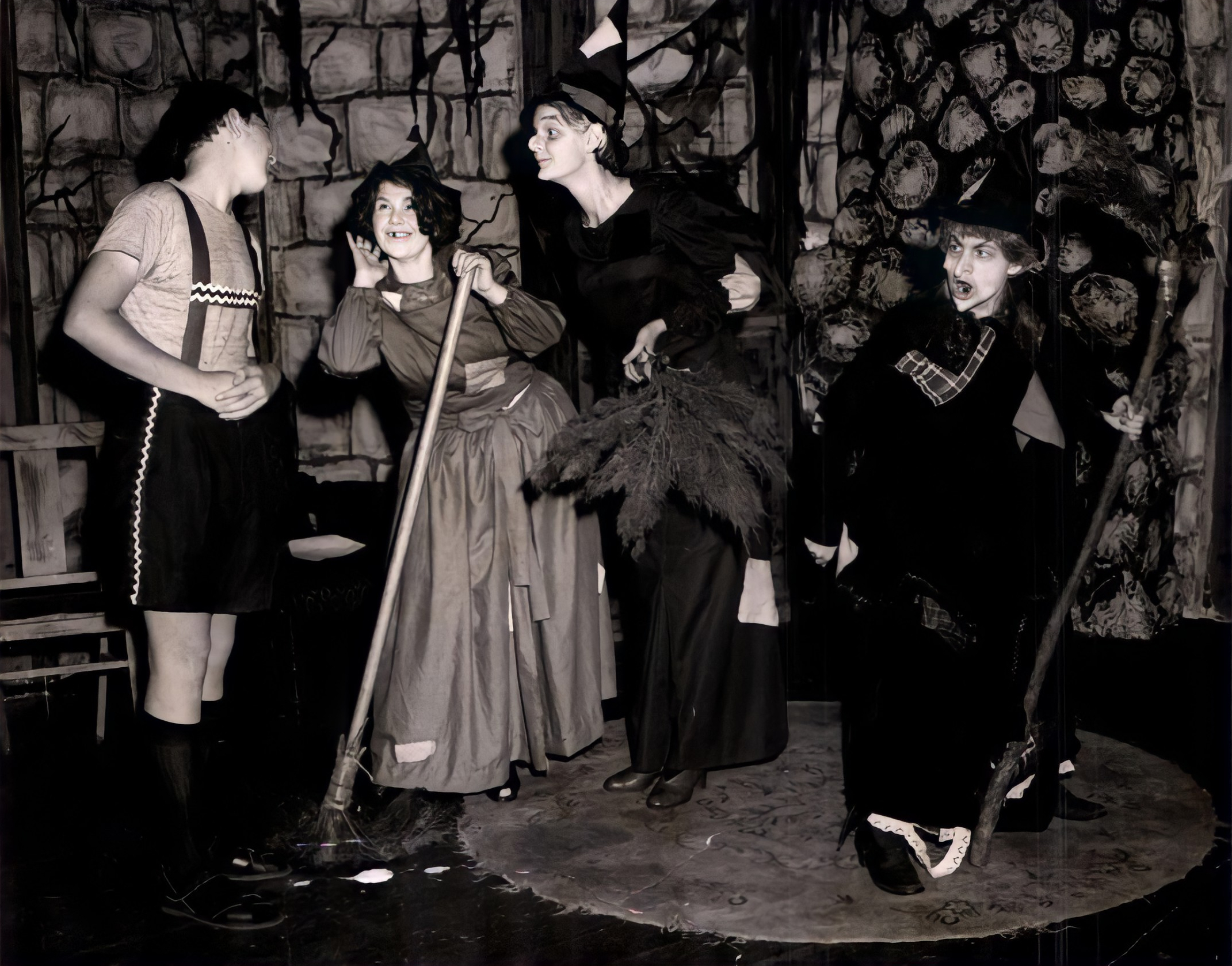 |
| 'Unwicked Witch' Slated at JM |
Dan Raaen, Tracey Bedney, Sue Clark and Barb Sauer in a scene from "The Unwicked Witch," John Marshall Summer Theater production to be presented Thursday and Friday in the school auditorium. Thursday's performance will be a 2:30 p.m. matinee, Friday's an evening show at 8.
(P-B Family Fare Photo)
|




